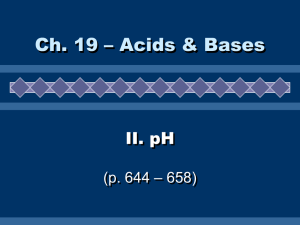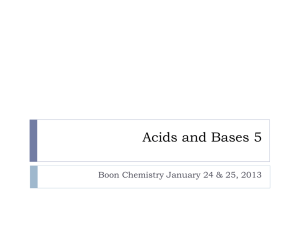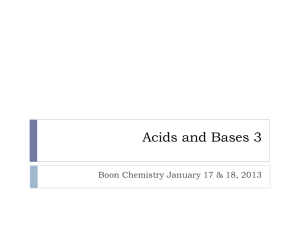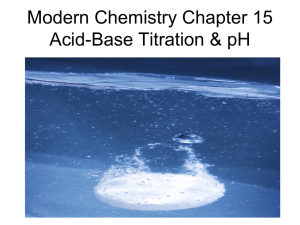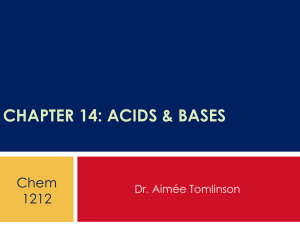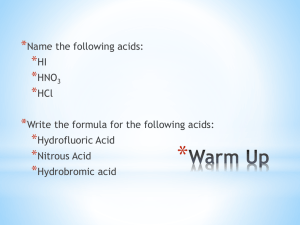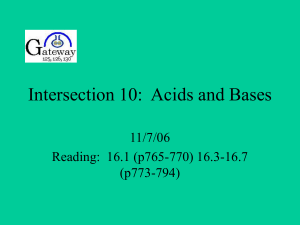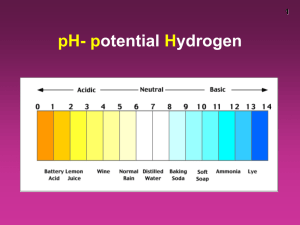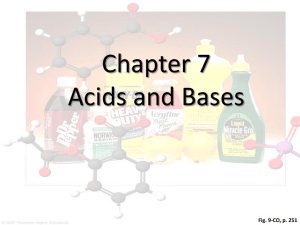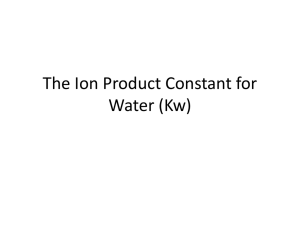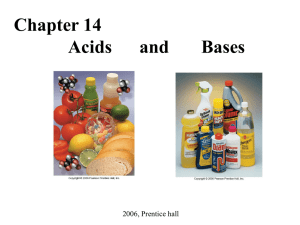Acids and Bases
advertisement
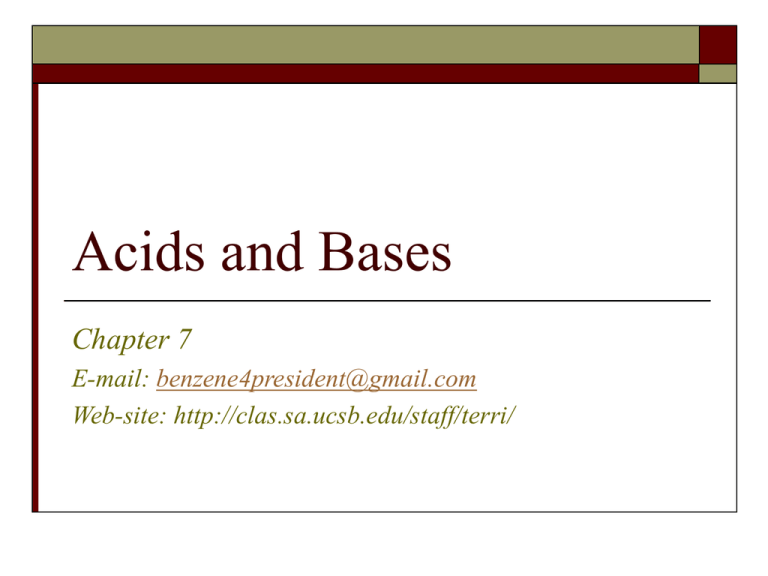
Acids and Bases Chapter 7 E-mail: benzene4president@gmail.com Web-site: http://clas.sa.ucsb.edu/staff/terri/ Acids and Bases – ch. 7 1. Arrange the following solutions in order of most acidic to most basic. A) [OH– ] = 0.5 M B) [H+ ] = 0.3 M C) pOH = 5.9 D) pH = 1.2 E) [H+ ] = 1.0x10–4M Acids and Bases – ch. 7 pH = -log[H3O+] [H3O+] pH [H3O+] = 10-pH Kw = [H3O+][OH-] pKw = pH + pOH pOH = -log[OH-] [OH-] pOH [OH-] = 10-pOH Acids and Bases – ch. 7 2. At 25°C the water ionization constant is 1.0 x 10–14 and at 98°C the water ionization constant is 6.8 x 10–14. What is the pH of neutral water at both temperatures? Acids and Bases – ch. 7 3. a. Which of the following is a stronger acid? HNO2 (Ka = 4.0 x 10–4) or HCN (pKa = 9.21) b. Which is a stronger base? NO2– or CN– Acids and Bases – ch. 7 As acid strength ↑ % ionization ↑ Ka ↑ pKa ↓ As base strength ↑ % ionization ↑ Kb ↑ pKb ↓ Conjugate pairs are inversely related As acid strength ↑ conjugate base strength ↓ Kw = (Ka)(Kb) Acids and Bases – ch. 7 4. Calculate the pH of the following solutions: a. 0.004 M HBr b. 0.25 moles of Ba(OH)2 in 7.50 L of solution Acids and Bases – ch. 7 5. Calculate the pH and the % ionization of the following solutions a. 0.05 M HClO (Ka = 3.0 x 10–8) b. 0.33 M CH3COOH (Ka = 1.8 x 10–5) mixed with 0.85 M HCN (Ka = 6.2 x 10–10) Acids and Bases – ch. 7 6. What concentration of HCOOH (Ka = 1.77x10-4) solution will have a pH of 2.2? Acids and Bases – ch. 7 7. A solution with 0.5 M of weak monoprotic acid ionizes 0.62% . What is the Ka for this acid? Acids and Bases – ch. 7 8. What concentration of a weak acid that ionizes 0.1% will have a pH of 3.8? Acids and Bases – ch. 7 9. What concentration of HNO2 (Ka = 4.0 x 10–4) will have the same pH as 0.004M HNO3? Acids and Bases – ch. 7 10. If 0.1M solution of a weak acid has a pH of 3 what will be the pH of a 0.001M solution of the weak acid? Acids and Bases – ch. 7 11. Calculate the pH and % ionization for the following: a. 0.01M NH3 (Kb = 1.8 x 10-5) b. 0.05 M C6H5NH2 (Kb = 3.8 x 10-10) Acids and Bases – ch. 7 12. If a 0.35 M solution of weak base has a pH of 11.2, what is the pH of a 0.08 M solution of the weak base? Acids and Bases – ch. 7 13. Rank the following 0.1 M salt solutions in order of increasing pH. a. NaClO4 b. LiF c. C5H5NHI d. NH4Cl e. KCN HF Ka = 7.2 x 10-4 C5H5N Ka = 1.7 x 10-9 NH3 Ka = 1.8 x 10-5 HCN Ka = 6.2 x 10-10 Acids and Bases – ch. 7 Salts ⇒ soluble ionic compounds that are the result of an acid base reaction ⇒ when a salt is dissolved in water each ion can potentially affect the pH of the solution ⇒ you need to analyze the ions individually Salts Cations Group 1 and 2 metal ions ⇒ neutral All other cations ⇒ acids Anions 1st 7 ⇒ neutral All other anions ⇒ bases Acids and Bases – ch. 7 14. How many grams of KF must be dissolved in 500 mL of water in order to get a pH of 8.4? (Ka of HF = 7.2 x 10-4) Acids and Bases – ch. 7 15. If a 1.2 M solution of NaA has a pH of 10.4, what is the ionization constant (Ka) for the acid HA? Acids and Bases – ch. 7 You have completed ch. 7 Answer Key – ch. 7 1. Arrange the following solutions in order of most acidic to most basic. A) [OH– ] = 0.5 M ⇒ pOH = -log(0.5) = 0.3 ⇒ pH = 14 - 0.3 = 13.7 B) [H+ ] = 0.3 M ⇒ pH = -log(0.3) = 0.52 C) pOH = 5.9 ⇒ pH = 14-5.9 = 8.1 D) pH = 1.2 E) [H+ ] = 1.0x10–4M ⇒ pH = -log(1.0x10–4) = 4 As a solution gets more acidic… [H+ ]↑, pH↓, [OH– ]↓, pOH↑ B, D, E, C, A Answer Key – ch. 7 2. At 25°C the water ionization constant is 1.0 x 10–14 and at 98°C the water ionization constant is 6.8 x 10–14. What is the pH of neutral water at these temperatures? If a solution is neutral ⇒ [H3O+] = [OH-] For all aqueous solutions ⇒ [H3O+]x[OH-] = Kw at 25°C ⇒ x2 = 1.0 x 10–14 ⇒ x = 1.0 x 10-7M = [H3O+] = [OH-] pH = -log(1.0 x 10-7M) pH = 7 at 98°C ⇒ x2 = 6.8 x 10–14 => x = 2.61x10-7M = [H3O+] = [OH-] pH = -log(2.61x10-7M) pH = 6.58 Answer Key – ch. 7 3. a. Which of the following is a stronger acid? HNO2 (Ka = 4.0 x 10–4) or HCN (pKa = 9.21) as Ka ↑ % ionization ↑ or acid strength ↑ pKa ↓ Ka =10-pKa ⇒ Ka for HCN =10-9.21 = 6.2x 10-10 Since Ka for HNO2 > Ka for HCN ⇒ HNO2 is a stronger acid b. Which is a stronger base? NO2– or CN– as acid strength ↑ conjugate base strength ↓ since HNO2 is the stronger acid ⇒ NO2– is the weaker base ⇒ CN– is the stronger base Answer Key – ch. 7 3. Predict if the following salts are acidic, basic or neutral. a. NaClO4 ⇒ Na+ (neutral) + ClO4– (neutral) ⇒ Neutral salt b. LiF ⇒ Li+ (neutral) + F– (weak base) ⇒ Basic salt c. C5H5NHI ⇒ C5H5NH+ (weak acid) + I–(neutral) ⇒ Acidic salt d. KNO3 ⇒ K+ (neutral) + NO3– (neutral) ⇒ Neutral salt e. NH4NO2 ⇒ NH4+ (weak acid) + F– (weak base) since there’s an acid and a base we need to compare their ionization constants: NH4+ ⇒ Ka = 5.6 x 10-10 verses NO2– ⇒ Kb = Kw of HNO2 ⇒ Kb = (1(4xx10–14) 10–4) Ka Kb = 2.5 x 10–11 since Ka > Kb it’s an Acidic salt Answer Key – ch. 7 4. Calculate the pH of the following solutions a. 0.004 M HBr ⇒ Strong acid [H3O+] = 0.004 M ⇒ pH = - log(0.004) ⇒ pH = 2.4 b. 0.25 moles of Ba(OH)2 in 7.50 L of solution ⇒ Strong base [OH-]= (0.25 𝑚𝑜𝑙𝑒𝑠 Ba(OH)2)(2 𝑚𝑜𝑙𝑒𝑠 𝑂𝐻−𝑝𝑒𝑟 1 𝑚𝑜𝑙𝑒Ba(OH)2) pOH = -log(0.067M) = 1.18 pH = 14-1.18 = 12.82 7.5 𝐿 = 0.067M Answer Key – ch. 7 5. Calculate the pH and the % ionization of the following solutions a. 0.05 M HClO (Ka = 3.0 x 10–8) ⇒ weak acid ⇌ H3O+ ClO2– N/A 0 0 -x N/A +x +x 0.04- x N/A x x HClO H2O I 0.04 ∆ Eq Insignificantly small Use Ka to solve for x 3 x 10–8 = (x)(x) 0.04 x = 3.46 x 10–5 M [H3O+] = 3.46 x 10–5 M pH = - log(3.46 x 10–5 M) = 4.46 +] [H O 3 % ionized = x100 [HClO] 5 3.46 x 10– % ionized = x100 = 0.086% 0.04 Answer Key – ch. 7 5. …continued b. 0.33 M CH3COOH (Ka = 1.8 x 10–5) mixed with 0.85 M HCN (Ka = 6.2 x 10–10) CH3COOH H2O ⇌ H3O+ CH3COO- I 0.33 N/A 0 0 ∆ -x N/A +x +x Eq 0.33 - x N/A x x Insignificantly small If you have 2 or more acids only the strongest acid will contribute significantly to the pH Since acetic acid is stronger we can ignore the HCN 2 x –5 1.8 x 10 = 0.33 x = 0.00244M = [H3O+] pH = -log(0.00244) = 2.61 % ionized = 0.00244 = 0.74% 0.33 Answer Key – ch. 7 5. …continued c. 0.04 M NH4I (for NH3 Kb = 1.8 x 10–5) => if NH3 is a base then NH4+ must be an acid NH4+ H2O I 0.002 ∆ -x Eq 0.002 - x Insignificantly small ⇌ H3O+ NH3 N/A 0 0 N/A +x +x N/A x x Ka is necessary to solve for x => since NH4+ and NH3 are conjugates Ka = Kw K𝑏 Ka = 1x10−14 = 5.6x10-10 1.8x10−5 2 x -10 5.6x10 = 0.002 x = 1.06x10-6 pH = -log(1.06x10-6 ) = 5.98 %ionized = 1.06x10−6x100 = 0.053% 0.002 Answer Key – ch. 7 6. What concentration of HCOOH (Ka = 1.77x10-4) solution will have a pH of 2.2? Since the pH = 2.2 ⇒ [H+] = 10–2.2 M or 0.0063 M ⇒ since the molar ratio is 1:1 ⇒ [H+] = [HCOO–] ⇌ H3O+ HCOOH N/A 0 0 -0.0063 N/A +0.0063 +0.0063 x-0.0063 N/A 0.0063 0.0063 HCOOH H2O I x ∆ Eq insignificantly small 1.77 x 10-4 = (0.0063)(0.0063) x x = 0.224 Answer Key – ch. 7 7. If a solution with 0.5 M of unknown weak acid ionizes 0.026% identify the weak acid. Ka is a useful identification value ⇌ H3O+ A– N/A 0 0 -0.00026(0.5) N/A +0.00026(0.5) +0.00026(0.5) 0.5 N/A 0.00013 0.00013 HA H2O I 0.5 ∆ Eq Ka = (0.00013)(0.00013) = 3.4x10–8 ⇒ HOCl (0.5) Answer Key – ch. 7 8. What concentration of a weak acid that ionizes 0.1% will have a pH of 3.8? ⇌ H3O+ A– N/A 0 0 -0.001x N/A +0.001x +0.001x x -0.001x N/A 0.001x 0.001x HA H2O I x ∆ Eq Since the pH is 3.8 ⇒ [H3O+] = 10–3.8 or 1.58x10–4 1.58x10–4 = 0.0001x x = 1.58M Answer Key – ch. 7 9. What concentration of HNO2 (Ka = 4.0 x 10–4) will have the same pH as 0.004M HNO3? Same pH ⇒ same [H3O+] Since HNO3 is a strong acid ⇒ [H3O+] = 0.004M ⇌ H3O+ NO2– N/A 0 0 -0.004 N/A +0.004 +0.004 x – 0.004 N/A 0.004 0.004 HNO2 H2O I x ∆ Eq 4.0 x 10–4 = (0.004)(0.004) x = 0.04M x Answer Key – ch. 7 10. If 0.1M of a weak acid has a pH of 3 what will be the pH of a 0.001M solution of the weak acid? Same acid with different concentration will have the same Ka so you can set one Ka equation equal to another [H3O+][A−] = [H3O+][A−] [HA] [HA] If the pH = 3 ⇒ [H3O+] = 10–3 [0.001][0.001] = [x][x] [0.1] [0.001] x = 10–4 pH = -log(10–4) = 4 Answer Key – ch. 7 11. Calculate the pH and % ionization for the following: a. 0.01M NH3 (Ka of NH4+ = 5.6 x 10-10) NH3 is a weak base so you need Kb ⇒ Kb = Kw = 1 x 10−14 = 1.79x10–5 K 5.6 x 10−10 𝑎 ⇌ OH- NH4+ N/A 0 0 -x N/A +x +x 0.01-x N/A x x NH3 H2O I 0.01 ∆ Eq 1.79x10–5 = (x)(x) 0.01 x = 4.23x10–4 = [OH–] pOH = -log(4.23x10–4) pOH = 3.37 pH = 14 – 3.37 pH = 10.63 Answer Key – ch. 7 11. …continued b. 0.05 M KClO (Ka of HClO = 3 x 10-8) ⇒ ClO– is a weak base so you need Kb ⇒ Kb = Kw = 1 x 10−14 = 3.33x10–7 K 3 x 10−8 𝑎 ClO– H2O I 0.05 ∆ Eq ⇌ OH- HClO N/A 0 0 –x N/A +x +x 0.05 – x N/A x x 3.33x10–7 = (x)(x) 0.05 x = 1.29x10–4 = [OH–] pOH = -log(1.29x10–4) pOH = 3.89 pH = 14 – 3.89 pH = 10.11 Answer Key – ch. 7 12. How many grams of KF must be dissolved in 500 mL of water in order to get a pH of 8.4? (Ka of HF = 7.2 x 10-4) F– is a weak base ⇒ since the pH = 8.4 ⇒ pOH = 5.6 ⇒ [OH–] = 10–5.6 M or 2.51 x 10–6 M F– H2O ⇌ I x ∆ Eq OH– HF N/A 0 0 -2.51x10–6 N/A +2.51x10–6 +2.51x10–6 x-2.51x10–6 N/A 2.51x10–6 2.51x10–6 We need Kb to solve for x ⇒ Kb = Kw = 1 x10–14 K𝑎 7.2 x 10–4 Kb = 1.4 x 10–11 1.4 x 10–11 = (2.51x10–6)(2.51x10–6) ⇒ x = 0.45 x [F–] = 0.45 M (0.45 mol/L)(0.5 L) = 0.225 mol KF ⇒ (0.225 mol KF)(56.11 g/mol) = 12.6 g of KF Answer Key – ch. 7 13. If a 1.2 M solution of NaA has a pH of 10.4, what is the ionization constant for the acid HA? In order to get Ka for HA we’ll need Kb for A– ⇒ since the pH = 10.4 ⇒ pOH = 4.6 ⇒ [OH–] = 2.51 x 10–5 I A– H2O 1.2 ∆ Eq 1.2 ⇌ OH– HA N/A 0 0 N/A +2.51 x 10–5 +2.51 x 10–5 N/A 2.51 x 10–5 2.51 x 10–5 Kb for A– = (2.51 x 10–5 )(2.51 x 10–5) (1.2) Kb = 5.26 x 10–10 ⇒ Ka = Kw = 1 x10–14 = 1.9 x 10–5 K 5.26 x 10–10 𝑏

